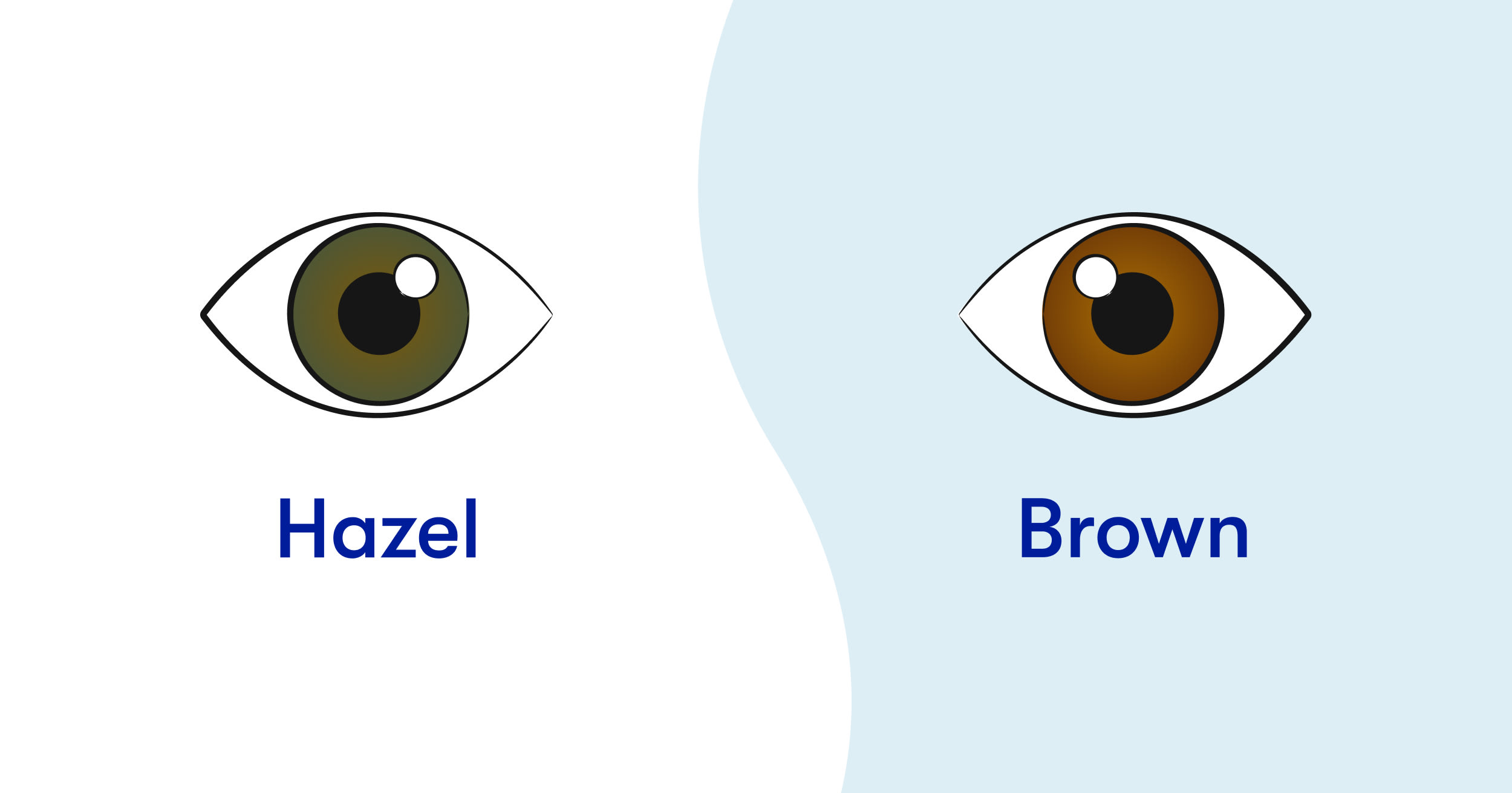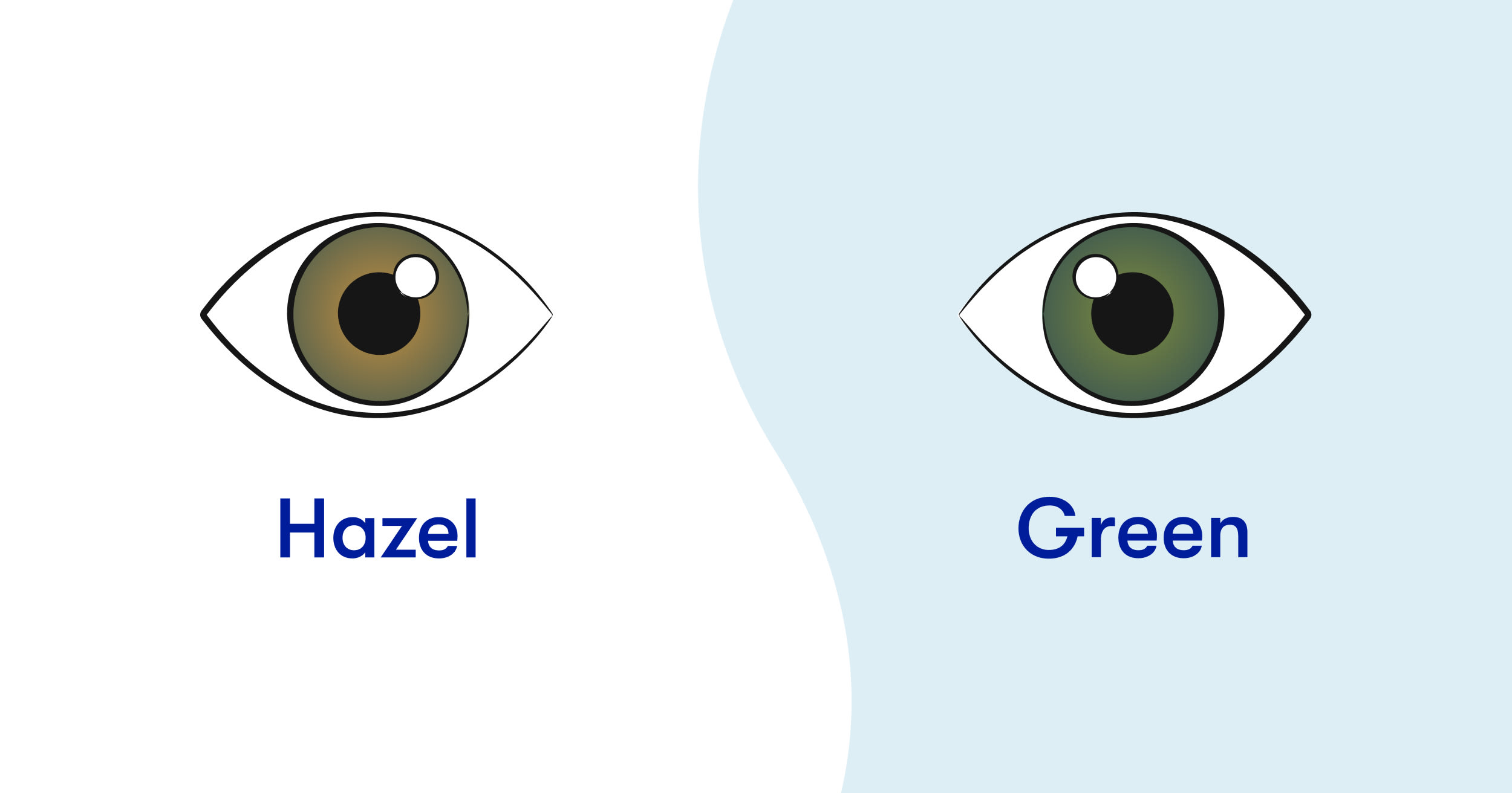What are considered hazel eyes?
Hazel eyes are a mixture of brown and green, with some gold around the iris. Some hazel-eyed folks also have specks of blue and amber in their rises.
Some of the unique characteristics of hazel eyes are:
Blue eyes get far too much of the spotlight, and we're here to give hazel eyes the podium they deserve. Keep reading to discover everything about hazel eyes, from genetics to cultural significance.
Hazel vs. brown eyes
The main differences between hazel and brown eyes are:

The difference between green and hazel eyes
Hazel eyes have a tinge of green, so sometimes they're also confused for greenish eyes. But they're not the same.
The main differences for hazel eyes vs. green eyes are:

Do hazel eyes change colors?
We're sorry to break it to all the people who proudly say, "My eye color changes daily." You're not the chameleon you think you are.
Because hazel eyes are made of different colors and can have flecks or rings of hues in one area, the coloring can shift in certain lighting. The clothing you wear can also have this effect. That favorite plum sweater in your closet isn't enchanted; it just enhances those green spots more than your other accessories.
And yet, never say never.
There are some instances where eyes can truly change color, but we're talking about rare and small changes. Medications, conditions such as cataracts, and aging can cause this occurrence.
Lastly, of course, someone could temporarily change their eyes to hazel with color-changing contacts. People use color contacts for movies, photoshoots, and costumes, but it's also an option to spice up the everyday.
Hazel eyes genetics
Your eyes are all about your genes — what your mom and dad gave you. So, let’s explore how hazel eyes are inherited and why they're so rare.
How are hazel eyes inherited?
Eye genetics are quite complicated; recent research shows up to 16 genes can play a role in influencing eye color, which makes predicting eye color difficult. A child can have a different eye color than either of their parents. Still, the parents' eye colors are the most significant indicator of the child's eye color. So, two parents with hazel eyes are highly likely to produce a child with hazel eyes, but it's not guaranteed.
Are hazel eyes dominant or recessive?
Part of growing up is learning that some of the stuff we learned in school was simply not true. Remember doing those genetic tracing charts with recessive and dominant genes? You were told brown eyes are dominant, blue is recessive, and parents with this combo will make a brown-eyed child.
We now know your eyes are determined by several genes. So, to answer the question vaguely: Hazel eyes are neither dominant nor recessive.
What percentage of people have hazel eyes?
Why are hazel eyes so rare?
Complex genetic factors work together to develop the combination of low melanin and Rayleigh scattering that causes hazel eyes. Simply put, many factors have to align for this outcome. But when the stars do align, the finished product is stunning. While beauty is in the eye of the beholder, hazel eyes are commonly ranked among the most beautiful.
What ethnicity has hazel eyes?
Hazel eyes are most commonly found in people of European descent, but that's not exclusively true. They are also found in people from Middle Eastern, Latin American, and even Asian countries.
What do hazel eyes symbolize?
Because hazel eyes are a mixture of many colors, many sources say they symbolize harmony, balance, and versatility. Because they're quite rare, some believe they symbolize mystery, magic, and spiritual powers.
How to get hazel eyes
You can't exactly get an order form and request hazel eyes. Your genetics have made that decision for you. But thanks to modern technology, virtually anyone can have hazel eyes or change their eye color. Contacts can satisfy form and function and be both aesthetically pleasing and practical.
The colored contacts selection at 1-800 Contacts lets you choose from many popular brands so you can have hazel eyes in no time.
Did you know you can order contacts online?
Say goodbye to trips to the eye doctor and hello to convenience! With 1-800 Contacts, you can easily order your contact lenses online and have them delivered straight to your door. Plus, our online vision exam makes it simple to get the prescription you need without leaving home. And the best part? You’ll save money on your first order with 1-800 Contacts. It’s never been easier to get your contacts!
Original publish date: 1/17/25
Updated date: 3/20/25
Hazel Eye Color | 1-800 Contacts
%3Csvg%20width%3D%22137%22%20height%3D%2218%22%20viewBox%3D%220%200%20137%2018%22%20fill%3D%22none%22%20xmlns%3D%22http%3A%2F%2Fwww.w3.org%2F2000%2Fsvg%22%3E%0A%3Cpath%20d%3D%22M0%205.77831V7.42218L1.97264%206.73175V15.0497H0V16.6936H5.72066V15.0497H3.74802V4.39746L0%205.77831Z%22%20fill%3D%22white%22%2F%3E%0A%3Cpath%20d%3D%22M16.8006%208.11242C17.9513%207.42199%2018.6088%206.27128%2018.6088%204.85756C18.6088%202.75341%2016.8006%200.978027%2014.6635%200.978027C12.2635%200.978027%2010.4224%202.72053%2010.4224%204.98907C10.4224%206.36992%2011.1128%207.52062%2012.2964%208.17817C10.6854%208.86859%209.6333%2010.4796%209.6333%2012.255C9.6333%2014.8852%2011.8032%2016.9564%2014.5649%2016.9564C17.2937%2016.9564%2019.4965%2014.7865%2019.4965%2012.1563C19.4965%2010.4138%2018.4116%208.80284%2016.8006%208.11242ZM12.0991%205.05482C12.0991%203.70685%2013.1841%202.65477%2014.4992%202.65477C15.8142%202.65477%2016.8992%203.73973%2016.8992%205.0877C16.8992%206.40279%2015.8142%207.48775%2014.4992%207.48775C13.1841%207.48775%2012.0991%206.40279%2012.0991%205.05482ZM17.6225%2012.2221C17.6225%2013.9317%2016.2417%2015.3454%2014.532%2015.3454C12.7895%2015.3454%2011.4087%2013.9646%2011.4087%2012.2221C11.4087%2010.5453%2012.8224%209.13161%2014.4992%209.13161C16.2088%209.09874%2017.6225%2010.4796%2017.6225%2012.2221Z%22%20fill%3D%22white%22%2F%3E%0A%3Cpath%20d%3D%22M26.3346%204.06836C24.8551%204.06836%2023.3756%204.72591%2022.3564%205.84374C21.3701%206.86294%2020.9756%208.01364%2020.9756%209.69039V11.2685C20.9756%2013.011%2021.4687%2014.2603%2022.5537%2015.3453C23.6058%2016.3645%2024.9537%2016.9234%2026.3675%2016.9234C27.847%2016.9234%2029.3264%2016.2659%2030.3785%2015.148C31.332%2014.1288%2031.7265%2012.9452%2031.7265%2011.2685V9.72327C31.7265%207.94789%2031.2662%206.73143%2030.1484%205.64647C29.1292%204.66015%2027.7483%204.06836%2026.3346%204.06836ZM29.8854%209.75614V11.3343C29.8854%2012.3206%2029.7867%2013.0768%2029.2607%2013.8329C28.6031%2014.7206%2027.4853%2015.2795%2026.3346%2015.2795C25.1839%2015.2795%2024.1318%2014.7535%2023.4743%2013.8658C22.8825%2013.0768%2022.751%2012.2877%2022.751%2011.3014V9.72327C22.751%208.8027%2022.8496%208.01364%2023.4085%207.22459C24.0332%206.30402%2025.151%205.74511%2026.3017%205.74511C27.4524%205.74511%2028.5374%206.27114%2029.162%207.15883C29.7867%207.94789%2029.8854%208.73695%2029.8854%209.75614Z%22%20fill%3D%22white%22%2F%3E%0A%3Cpath%20d%3D%22M38.4996%204.06836C37.0202%204.06836%2035.5407%204.72591%2034.5215%205.84374C33.5352%206.86294%2033.1406%208.01364%2033.1406%209.69039V11.2685C33.1406%2013.011%2033.6338%2014.2603%2034.7187%2015.3453C35.7708%2016.3645%2037.1188%2016.9234%2038.5325%2016.9234C40.012%2016.9234%2041.4915%2016.2659%2042.5435%2015.148C43.497%2014.1288%2043.8915%2012.9452%2043.8915%2011.2685V9.72327C43.8915%207.94789%2043.4312%206.73143%2042.3134%205.64647C41.2942%204.66015%2039.9134%204.06836%2038.4996%204.06836ZM42.0504%209.75614V11.3343C42.0504%2012.3206%2041.9518%2013.0768%2041.4257%2013.8329C40.7682%2014.7206%2039.6503%2015.2795%2038.4996%2015.2795C37.3489%2015.2795%2036.2969%2014.7535%2035.6393%2013.8658C35.0475%2013.0768%2034.916%2012.2877%2034.916%2011.3014V9.72327C34.916%208.8027%2035.0146%208.01364%2035.5735%207.22459C36.2311%206.30402%2037.316%205.74511%2038.4668%205.74511C39.6175%205.74511%2040.7024%206.27114%2041.3271%207.15883C41.9189%207.94789%2042.0504%208.73695%2042.0504%209.75614Z%22%20fill%3D%22white%22%2F%3E%0A%3Cpath%20d%3D%22M57.3712%2013.011C56.7794%2014.359%2055.3328%2015.2467%2053.7547%2015.2467C51.3546%2015.2467%2049.4806%2013.4384%2049.4806%2011.1041C49.4806%208.73695%2051.3218%206.86294%2053.656%206.86294C55.1355%206.86294%2056.5164%207.652%2057.2726%208.90134L57.3054%208.96709H58.8507V5.35058H57.2397V6.66568C56.2205%205.67936%2054.9711%205.15332%2053.5574%205.15332C52.0122%205.15332%2050.5656%205.77799%2049.4149%206.96158C48.3628%208.04653%2047.771%209.55889%2047.771%2011.1041C47.771%2014.2604%2050.4669%2016.9563%2053.6232%2016.9563C56.1547%2016.9563%2058.3904%2015.4111%2059.2123%2013.1096L59.2781%2012.8795H57.4041L57.3712%2013.011Z%22%20fill%3D%22white%22%2F%3E%0A%3Cpath%20d%3D%22M66.0177%205.18652C62.73%205.18652%2060.0669%207.84959%2060.0669%2011.1044C60.0669%2014.3593%2062.73%2016.9895%2065.9848%2016.9895C69.2397%2016.9895%2071.9027%2014.2936%2071.9027%2011.0058C71.9027%207.78384%2069.2726%205.18652%2066.0177%205.18652ZM70.1931%2011.0716C70.1931%2013.4059%2068.2862%2015.2799%2065.9848%2015.2799C63.6505%2015.2799%2061.7765%2013.373%2061.7765%2011.0387C61.7765%208.73728%2063.6834%206.83039%2066.0177%206.83039C68.3191%206.86327%2070.1931%208.73728%2070.1931%2011.0716Z%22%20fill%3D%22white%22%2F%3E%0A%3Cpath%20d%3D%22M83.7387%2010.3151C83.7387%208.83558%2083.3442%207.84926%2083.114%207.3561C82.3907%205.9095%2080.5496%205.15332%2079.1687%205.15332C77.7221%205.15332%2076.407%205.81087%2075.6509%206.86294V5.35058H72.1001V6.96158H73.9412V15.0494H72.1001V16.6604H77.492V15.0494H75.6509V10.6438C75.6509%209.72327%2075.6509%208.76983%2076.3413%207.9479C76.9331%207.25747%2077.8536%206.86294%2078.8071%206.86294C79.3989%206.86294%2080.8784%206.99445%2081.5359%208.11228C81.9962%208.90134%2082.0291%209.75615%2082.0291%2010.8082V15.0494H80.1879V16.6604H85.5798V15.0494H83.7387V10.3151Z%22%20fill%3D%22white%22%2F%3E%0A%3Cpath%20d%3D%22M88.5057%2012.0907V6.99475H90.9386V5.38376H88.5057V1.43848H86.796V5.38376H84.6919V6.99475H86.796V12.4195C86.796%2015.4771%2087.9468%2016.9895%2090.3139%2016.9895H91.103V15.3456H90.3139C88.5057%2015.3127%2088.5057%2013.6689%2088.5057%2012.0907Z%22%20fill%3D%22white%22%2F%3E%0A%3Cpath%20d%3D%22M101.756%207.38931C100.704%205.90983%2099.2569%205.18652%2097.4158%205.18652C95.3774%205.18652%2093.4376%206.2386%2092.5171%207.88247L92.4842%207.94822C92.0239%208.73728%2091.5965%209.49346%2091.5965%2011.1044C91.5636%2012.2552%2091.8924%2013.3401%2092.4842%2014.3593C93.4705%2016.0032%2095.3774%2017.0224%2097.4487%2017.0224C99.224%2017.0224%20100.769%2016.2333%20101.756%2014.8196V16.7265H104.945V15.1155H103.465V6.99478H104.945V5.38379H101.756V7.38931ZM101.788%2011.0716C101.788%2013.4716%2099.9145%2015.3128%2097.5144%2015.3128C95.2459%2015.3128%2093.3061%2013.373%2093.3061%2011.1044C93.3061%208.77016%2095.213%206.86327%2097.5802%206.86327C99.8816%206.86327%20101.788%208.73728%20101.788%2011.0716Z%22%20fill%3D%22white%22%2F%3E%0A%3Cpath%20d%3D%22M114.874%2013.011C114.282%2014.359%20112.835%2015.2467%20111.257%2015.2467C108.857%2015.2467%20106.983%2013.4384%20106.983%2011.1041C106.983%208.73695%20108.824%206.86294%20111.158%206.86294C112.638%206.86294%20114.019%207.652%20114.775%208.90134L114.808%208.96709H116.353V5.35058H114.742V6.66568C113.723%205.64648%20112.474%205.15332%20111.06%205.15332C109.515%205.15332%20108.068%205.77799%20106.917%206.96158C105.865%208.04653%20105.273%209.55889%20105.273%2011.1041C105.273%2014.2604%20107.969%2016.9563%20111.126%2016.9563C113.657%2016.9563%20115.893%2015.4111%20116.715%2013.1096L116.781%2012.8795H114.907L114.874%2013.011Z%22%20fill%3D%22white%22%2F%3E%0A%3Cpath%20d%3D%22M121.35%2012.0907V6.99475H123.783V5.38376H121.35V1.43848H119.641V5.38376H117.537V6.99475H119.641V12.4195C119.641%2015.4771%20120.791%2016.9895%20123.159%2016.9895H123.948V15.3456H123.159C121.35%2015.3127%20121.35%2013.6689%20121.35%2012.0907Z%22%20fill%3D%22white%22%2F%3E%0A%3Cpath%20d%3D%22M131.838%2010.9728C131.049%2010.5125%20130.096%2010.2824%20129.307%2010.1508C128.09%209.88782%20127.005%209.55905%20127.005%208.37547C127.005%207.25764%20128.024%206.66584%20129.011%206.66584C129.537%206.66584%20130.063%206.83023%20130.457%207.12613C130.852%207.42202%20131.082%207.84943%20131.115%208.34259V8.50697H132.561V5.38363H131.115V6.10693C130.556%205.51513%20129.767%205.21924%20128.781%205.21924C127.827%205.21924%20126.479%205.54801%20125.756%206.50146C125.328%207.06037%20125.164%207.65216%20125.164%208.4741C125.164%209.4933%20125.657%2010.381%20126.545%2010.9399C127.268%2011.4002%20128.09%2011.5646%20128.912%2011.729L129.076%2011.7618C130.26%2011.992%20131.477%2012.255%20131.477%2013.6358C131.477%2014.8523%20130.359%2015.5756%20129.241%2015.5756C127.827%2015.5756%20126.709%2014.655%20126.611%2013.4057V13.2742H125.164V16.7263H126.611V15.7729C127.268%2016.5948%20128.255%2017.0222%20129.504%2017.0222C130.95%2017.0222%20132.331%2016.3318%20132.857%2015.3126C133.12%2014.8194%20133.351%2014.2934%20133.351%2013.5372C133.285%2012.4194%20132.759%2011.4988%20131.838%2010.9728Z%22%20fill%3D%22white%22%2F%3E%0A%3C%2Fsvg%3E%0A







